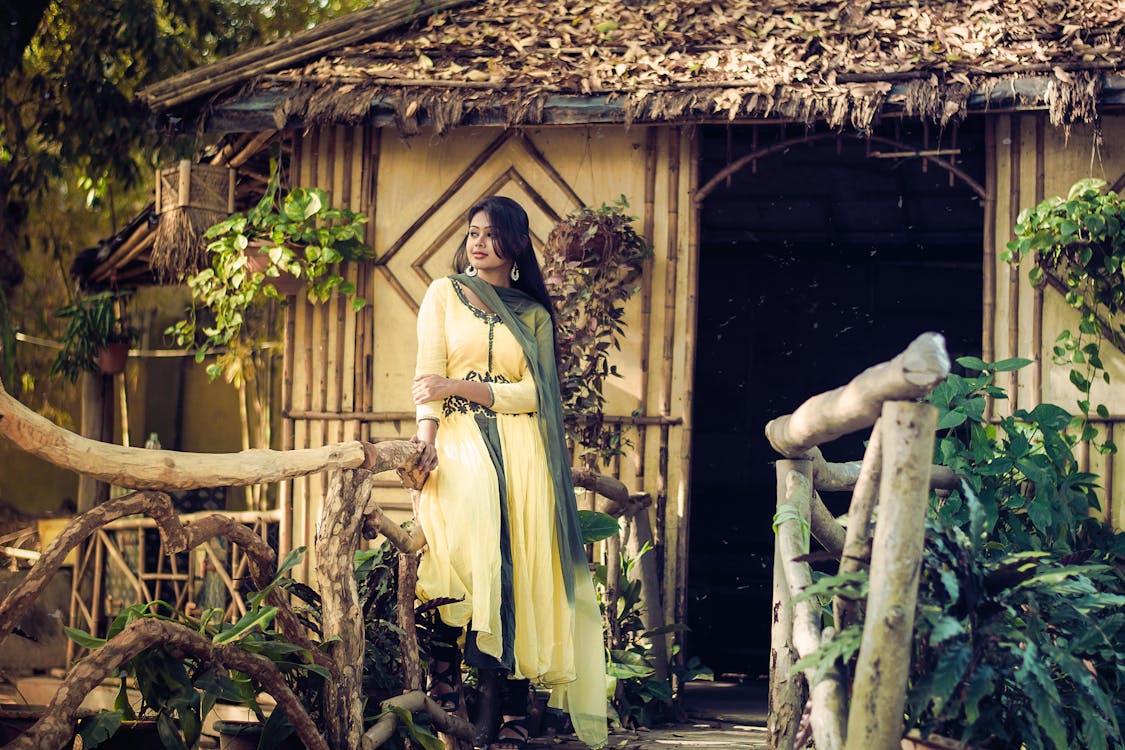In India, ethnic wear holds immense significance in our cultural inheritance. In the present era of globalization, Indian customs and traditions have paved the way for the western influence on clothing. But still, Indian ethnic wear has its charm, and it is the heritage that distinguishes us from other cultures worldwide. The colors, the designs, the patterns, the fabric, the drapes, and the feel of ethnic wear are iconic and class apart. To feel the essence of this traditional wear is not just to wear it but to carry it with grace and elegance.
The art of wearing Indian ethnic wear beautifully lies in discovering the right balance of classic and contemporary. A perfect outfit for every occasion is essential, and one should know the tips and tricks to make the most of their ensembles. Be it a saree, lehenga choli, kurti, salwar kameez, or even a dupatta, each of them represents the cultural and regional heritage of the vast and diverse country.
The market is flooded with ethnic wear options ranging from simple cotton kurtas to heavily embellished lehengas. Choosing the right option of ethnic wear is crucial to elevate one’s personality and aura. For instance, picking up a light-colored and simple kurti can be elegant for a casual day at work. Simultaneously, a heavily embroidered anarkali saree with delicate jewelry pieces can make anyone look like a diva at a wedding function.
Wearing ethnic wear isn’t just a trend in India; it’s also gaining popularity across the world. Over time, Westerners have started to appreciate the uniqueness of Indian clothing and are adopting it as a fashion statement. For these reasons, it is essential to know the fundamental rules of dressing up in Indian ethnic wear because everyone should own at least one dazzling piece of rich Indian attire.
To master the art of wearing ethnic wear, one must-have accessories that complement the outfit. Indian ethnic wear pairs well with many different accessories, including statement clutch purses, tote bags, bangles, and earrings. Simple jewelry pieces can also add a pop of elegance to a dress while highlighting the outfit’s intricate details.
Like any ensemble, ethnic wear requires attention to detail. The drape of the saree or dupatta, for instance, will make a considerable difference in the outfit’s overall look. The fabric and cuts of the outfit deserve personalized attention for the perfect look.
In conclusion, ethnic wear is much more than just dressing up. It’s a part of our cultural heritage, and we should take pride in wearing and showcasing it. Whether you are an Indian-born or an admirer of its culture from around the world, it’s essential to know the basics of Indian ethnic wear styling. With the essential tips and tricks, you can rock ethnic wear like a pro!
Understanding the Different Styles of Indian Ethnic Wear
Indian ethnic wear is a world of fashion that has many different styles and flavours. Some popular forms include sarees, salwar kameez, lehenga choli, and churidar suits. Each of these has their unique style and can be worn for different occasions. It’s important to understand the versatility of ethnic wear so that you can select the right outfit for the right event.
For instance, sarees can be both elegant and casual, while salwar kameez is more comfortable and relaxed. Lehenga choli is great for weddings or other grand events, while churidar suits are perfect for religious ceremonies. It’s essential to familiarize yourself with the different styles so you can choose the one that suits your personality, body type, and occasion.
Choosing the Right Fabric
The fabric you choose to wear plays a very significant role in completing the entire look. Indian ethnic wear comes in a variety of fabrics like cotton, silk, chiffon, georgette, and more. Choosing the best one can be a tough task. While cotton is the most comfortable material, it might not be appropriate for weddings where one is expected to dress up grandly.
For instance, if you are attending a grand event, opt for silk or chiffon. Such fabrics give the outfit a rich look that matches the grandeur of the occasion. On the other hand, if it is a more casual event, go for cotton, which is more breathable and comfortable for longer wear.
Accessorizing Your Indian Ethnic Wear
Accessorising your ethnic wear with the right jewellery and footwear can make a big difference in how you look. For instance, if you choose to wear a saree, you can accessorise it with a beautiful necklace and earrings that complement the saree’s colour. Bindi and bangles are other accessories that can enhance your overall look.
When it comes to footwear, ethnic wear matches perfectly with traditional footwear such as juttis, kolhapuris, mojaris, and sandals. It’s important to match the footwear with the outfit so that it doesn’t end up looking out of place.
Customizing Your Indian Ethnic Wear
Customizing your ethnic wear can add a touch of your personality to your outfit. If you want to add some bling to your outfit, then adding some embroidery or embellishments in the form of sequins, zari, or mirror work will add the necessary sparkle to your outfit. Customizing can also be done to a pre-existing outfit to make it fit better or to reshape it to make it more modern.
When you customize your outfit, you can also choose to add accessories such as buttons, zippers, or laces that enhance the overall look of the outfit. When customizing, work with a tailor or designer who can help improve the look of the outfit.
Make-Up and Hairstyles for Indian Ethnic Wear
Your make-up and hairstyle can make just as much of an impact on your Indian ethnic wear as the outfit itself. When it comes to make-up, go for either bold eyes or bold lips, which complement the outfit’s colours. Soft curls, buns, braids and loose waves are popular hairstyles that go well with Indian ethnic wear.
You can also opt for traditional hairstyles like the bun or braid adorned with flowers or other accessories. It’s important to tie your hair up or at least pin it neatly so that it doesn’t take away from the outfit.
Tips for Men
Indian ethnic wear is not just for women; men can also look dashing in traditional Indian wear. The men’s wear segment has various styles, including the kurta pajama, sherwani, and dhoti kurta. Men can match their outfit with traditional juttis, kolhapuris or mojaris.
Accessories like a stole, a turban or a safa can complete the overall look of the outfit. Men can also experiment with hair by styling it in a side part or a quiff, and by keeping facial hair well-groomed.
Summary
In India, ethnic wear is a significant part of the country’s cultural heritage, and it distinguishes its people from other cultures worldwide. However, with Western influence on clothing, the art of wearing Indian ethnic wear beautifully lies in striking the right balance of classic and contemporary. The market offers a wide range of options, from simple cotton kurtas to heavily embellished lehengas, and wearing ethnic wear requires attention to detail, such as draping and fabric choice. Ethnic wear is gaining popularity across the world, and to rock it like a pro, one must-have accessories that complement the outfit.

FAQ
What is the most flattering style for Indian ethnic wear?
The most flattering style for Indian ethnic wear will depend on your body type. For instance, if you have a pear-shaped body, A-line kurtas with straight pants can flatter your figure. Similarly, if you are tall and slender, floor-length Anarkali suits may add an extra edge to your outfit with heavy embroidery work. On the other hand, if you are curvy, you can choose from a range of sarees and lehengas that accentuate your curves. It is also essential to keep in mind the occasion and the time of day while selecting a style. Choose lighter materials such as chiffon or cotton for daytime events and heavier fabrics for evening events.
How can I accessorize my Indian ethnic wear?
Accessories play a vital role in enhancing your Indian ethnic wear outfits. Matching earrings, bangles, and necklaces can give a simple outfit a more elaborate look. If you’re going for a contemporary look, you can opt for chunky jewelry pieces like jhumkas or chandeliers with your outfit. For a more traditional look, you can opt for delicate and intricate designs. You can pair your outfits with a clutch and footwear that matches your attire. Footwear can instantly add panache to your outfit, and juttis, mojaris, and kolhapuris are traditional options that can bring a touch of authenticity to the look.
Can I mix and match ethnic outfits?
Yes, you can mix and match ethnic outfits to create a unique look. You can pair a lehenga skirt with a contrasting blouse or a saree with a jacket to add a modern twist. Mixing prints and textures with the right colors can also create an edgy look. It is important to ensure that the prints you choose complement each other and do not clash. You can also experiment with contrasts and color blocking, like pairing a mustard-colored skirt with a green blouse. However, make sure that you don’t overdo it and keep it subtle.
What are the common mistakes to avoid while wearing Indian ethnic wear?
One of the most common mistakes that people make while wearing Indian ethnic wear is choosing outfits that do not fit properly or are too loose. It is essential to get your clothes tailored to fit you perfectly. Another mistake is overdoing the accessories or the makeup, which can take away from the elegance and beauty of Indian ethnic wear. It is essential to strike a balance and keep it simple. Additionally, make sure that you wear the right undergarments to ensure that your outfit looks smooth and flawless. Lastly, avoid wearing outfits that are uncomfortable or hard to manage, as they can take away from the enjoyment of the event.




